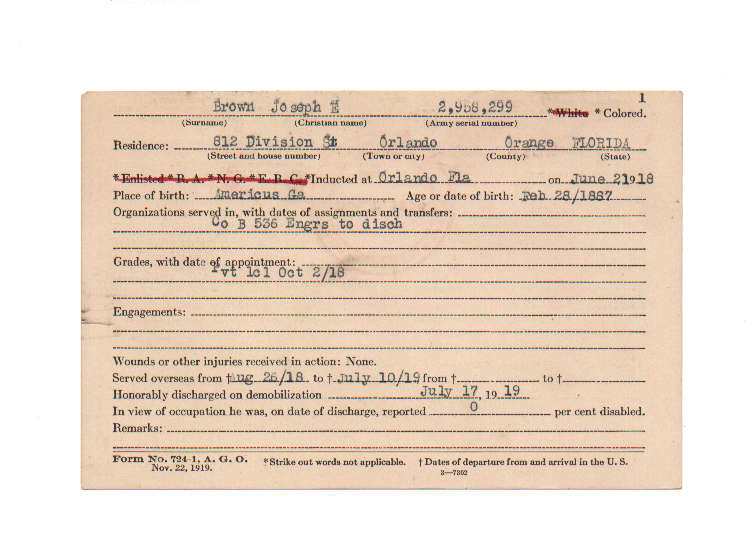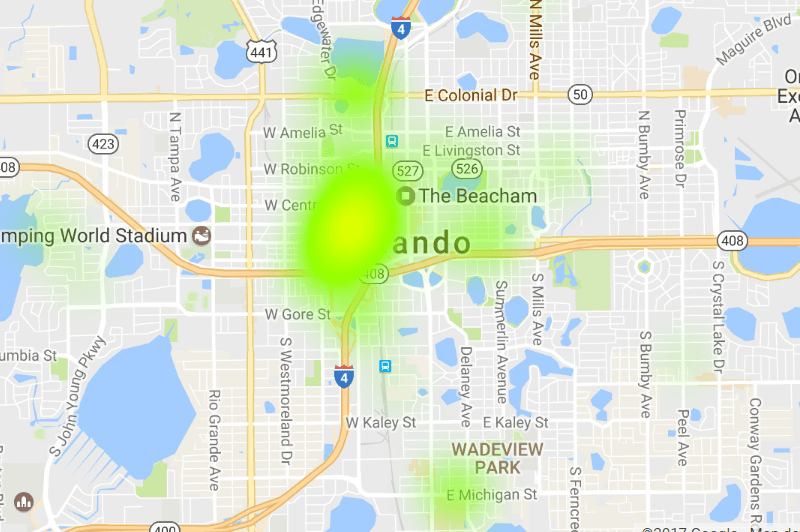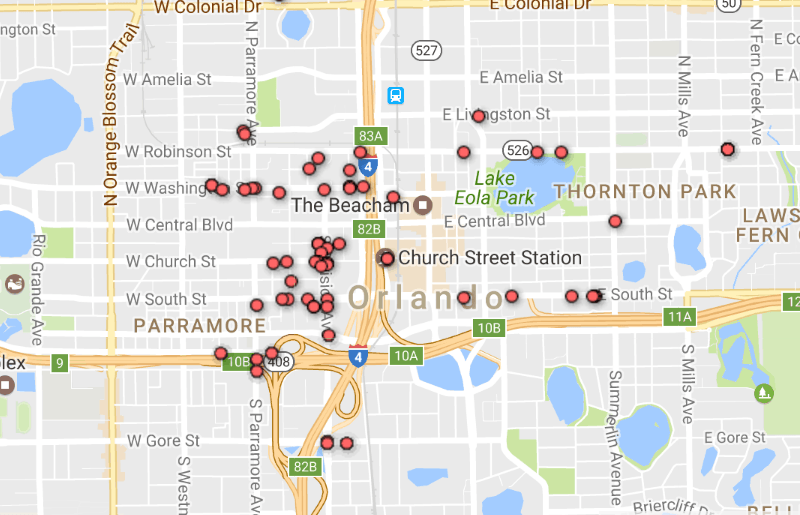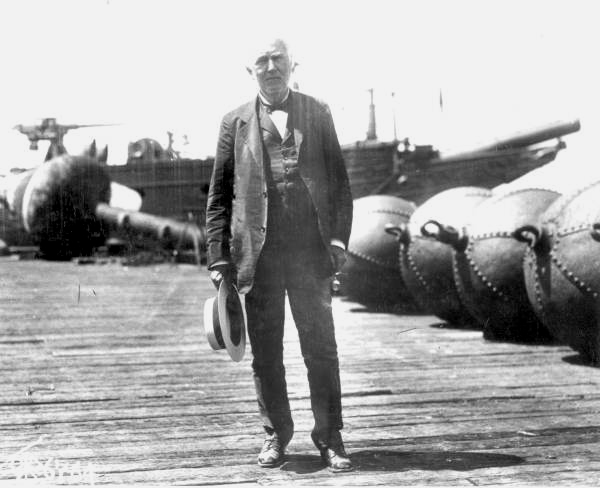Entry Composed by Kathryn Rinehart
Florida’s military aviation presence arguably dated to a 1910 Tampa demonstration. Military hangars were added to Florida’s landscape just before and during the Great War (1916). In Pensacola, Key West, and Miami aviation programs were initiated by the United States Navy. Free kite balloons and dirigibles among other vessels were part of the Navy’s World War I arsenal.1
Heavier-than-air aviation exploration and development occurred worldwide following the successful Wright Brothers’ 17 Dec 1903 Kitty Hawk flight. The French, British, and Italians made significant design and manufacturing advances in the ensuing decade. Contention over patent rights between the Wright Brothers and Glenn Curtiss likely contributed to the United States lagging behind other nations in research and development. American scientists and inventors, such as Alexander Graham Bell, expressed concern regarding the United States’ second-tier status in aviation. Bell, recipient of Glenn Curtiss’ first built airplane in 1908, was an informed observer.2
No absolute consensus of aviation’s value to military operations existed in 1914, despite aviation elements existing within the United States Army, Navy, and Marine Corps. The Navy first established a Florida aviation presence in 1914 with its Pensacola aviation school. Though the military desired service member-to-service member pilot training, contractor schools provided pilot instruction in the early years. The Curtiss Flying School in Miami, operated by Glenn Curtiss and established in early 1917, was one such school.3
The Navy had approximately 60 heavier-than-air-rated aviators before 6 Apr 1917, including those in training status. Six Marine Corps and six Coast Guard pilots earned Naval aviator designation. USCG officer-aviator Lt. Stanley V. Parker (Naval Aviator 57, CG Aviator 4) first commanded Naval Air Station Key West. NAS Key West trained 500 aviators during the Great War. Officers and enlisted men, immigrant and native-born, staffed the Marine aviation section in Pensacola. Though some enlisted became pilots, most others were aviation mechanics. All three seagoing services trained on Naval ships and with seaplanes, a distinct difference between their training and the Army’s. Fifth Naval aviator and first Marine Corps aviator Alfred A. Cunningham underwent landplane flight instruction at the Army Aviation School – San Diego in 1916. With the 6 Apr 1917 declaration of war, collaboration amongst the services increased. Training in aerial gunnery, seaplanes, and land planes ensured versatility amongst America’s few military pilots.4
Although the Army’s main pilot training existed in other states such as Texas, war’s advent saw an airfield acquisition surge, especially leased airfields. Miami’s Cutler airfield (later renamed Chapman airfield) provided aerial gunnery practice and coastal flying experience. Arcadia’s Carlstrom and Dorr airfields were the Army’s dominant Florida aviation presence during World War I. The 1918 War Department named a Ft. Myers airfield Hiestand Field in memory of aviation instructor Benjamin Hiestand, designating it an auxiliary field to Carlstrom and Dorr.5
Florida Naval pilot training expanded from Pensacola to Key West, and Miami. The First Yale Unit took advanced training at West Palm Beach, but the city did not become a general aviation facility.6
Middleburg, Florida native and Marine Corps Aviator #5, Captain Roy S. Geiger, implemented First Marine Aviation Force training at Miami in April, 1918. First utilizing the Navy’s airfield, Captain Geiger obtained the Curtiss School’s airfield via a $1 lease for the war’s duration. It became the first designated Marine Flying Field. The Marine Corps Publicity Bureau’s 1918 recruiting film Flying With the Marines, shown in theaters from New York City to Arizona and elsewhere nationally, featured Miami-filmed scenes of the First Marine Aviation Force pilots. Training included “ground school, formation flying, aerobatics and tactics, gunnery and bombing, and reconnaissance” skills, including aerial photography. From Miami, the First Marine Aviation Force departed for duty on the European front. Marine Corps pilots performed the first recorded food-drop mission under combat conditions when they supplied an isolated French regiment near Stadenburg, Belgium October 1918. Flying approximately three months, that unit earned 32 commendations, including two Medal of Honor recipients (one posthumous), four Distinguished Service Medals, and 26 Navy Crosses.7
After the war, the Army sought to permanently acquire Carlstrom, Chapman, and Dorr airfields. Miami’s desire for a post-war military aviation presence was mixed. Heavy military budget cuts caused reduced military pilot numbers and forced cancellation of Florida airfield acquisitions. Carlstrom and Dorr airfields saw renewed utilization in World War II.8
Several military pilots with World War I Florida experience later resided in the Sunshine State. Among these were Ohio-born Marine Corps aviator and Navy Cross recipient Everett R. Brewer {involved in first Marine Corps aviator action downing a German plane} (Naples). Others, such as Marine Corps pilot Byron B. Freeland, were pre-World War I residents. Brewer and Freeland trained at Miami.9
Image: Inspection of troops at Key West Naval Air Station – Key West, Florida. 1917 or 1918. Black & white photonegative, 4 x 5 in. State Archives of Florida, Florida Memory. , accessed 9 February 2017.
“Footnotes” for Paragraphs:
- Kevin M. McCarthy and William L Trotter. Aviation in Florida. 1st ed. Sarasota, FL: Pineapple Press, 2003, 40-2; “History.” Accessed September 30, 2016. http://www.cnic.navy.mil/regions/cnrse/installations/nas_pensacola/about/history.html.
- “They Taught the World to Fly! Wright Brothers National Memorial, North Carolina.” Accessed November 24, 2016. https://www.nps.gov/wrbr/index.htm.; James J. Hudson. Hostile Skies: A Combat History of the American Air Service in World War I. Syracuse, N.Y.: Syracuse University Press, 1996, 13; William F. Trimble. Hero of the Air. Annapolis, MD: Naval Institute Press, 2010, 183-4; Eugene M. Emme, ed. The Impact of Air Power: National Security and World Politics. Princeton, N.J.: D. Van Nostrand Company, Inc., 1959. 30-3; The Weekly Miami Metropolis (Miami, FL) “Miami Aviation School in Government Plan to Train Efficient Corps.” January 12, 1917.
- “History.” Accessed September 30, 2016. http://www.cnic.navy.mil/regions/cnrse/installations/nas_pensacola/about/history.html ; William F. Trimble. Hero of the Air. Annapolis, MD: Naval Institute Press, 2010, 125, 164.
- Reginald Wright Arthur.Contact! Careers of Naval Aviators Assigned Numbers 1 to 2,000. Washington: Naval Aviator Register, 1967, 4-5, 35-38; “History.” Accessed September 30, 2016. http://www.cnic.navy.mil/regions/cnrse/installations/nas_key_west/about/history.html; com. U.S. Marine Corps Muster Rolls, 1798-1958 [database on-line]. Provo, UT, USA: Ancestry.com Operations Inc, 2007; “U.S. Marines to Have Part in Flying Game.” Evening Star. (Washington, D.C.), 29 July 1918. Chronicling America: Historic American Newspapers. Lib. of Congress; Robert B. Workman, Float Planes & Flying Boats: The U.S. Coast Guard and Early Naval Aviation. Annapolis, MD: Naval Institute Press, 2012, xix-xx; “Official Declarations of War by Congress.” Accessed November 24, 2016. http://www.senate.gov/pagelayout/history/h_multi_sections_and_teasers/WarDeclarationsbyCongress.htm.
- Frederick J Shaw, ed. Locating Air Force Base Sites: History’s Legacy. Washington D.C.: Air Force History and Museums Program, United States Air Force, 2004, 12-3; Raymond G. McGuire. “Chapman Field: The Evolution of a South Dade Army Airdrome.” Tequesta 61, (January 2001): 59. America: History & Life, EBSCOhost (accessed October 24, 2016); Robert D. Swanson. Domestic United States Military Facilities of the First World War (1917-1919) – A Postal History. Wailuku, HI: Privately published, 2001, 59; Charles L. Morris. “Letters from Soldiers.” States-Graphic (Brownsville, TN), Sep. 6, 1918. Chronicling America: Historic American Newspapers. Lib. of Congress. http://chroniclingamerica.loc.gov/lccn/sn89058012/1918-09-06/ed-1/seq-1/; “Location of the Cantonments: List of Different Army Cantonments, Forts, Aviation Fields, Etc. and Where They Are Located.” The Denison Review (Denison, Iowa) July 31, 1918. Chronicling America: Historic American Newspapers. Lib. of Congress; The Chattanooga News. (Chattanooga, Tenn.) “New Aviation Field Named for Benjamin Hiestand, Instructor.” August 8, 1918. Chronicling America: Historic American Newspapers. Lib. of Congress. <http://chroniclingamerica.loc.gov/lccn/sn85038531/1918-08-08/ed-1/seq-1/>.
- Reginald Wright Arthur.Contact! Careers of Naval Aviators Assigned Numbers 1 to 2,000. Washington: Naval Aviator Register, 1967, 36, 521, 525, 530.
- Reginald Wright Arthur.Contact! Careers of Naval Aviators Assigned Numbers 1 to 2,000. Washington: Naval Aviator Register, 1967, 31; “Capt. Geiger’s USMC Orders to Miami (Courtesy of the History Division, Marine Corps University, Quantico).” City of Miami Springs (FL). Accessed August 15, 2016. http://www.miamisprings-fl.gov/sites/default/files/fileattachments/community/page/19821/capt._geigers_orders_to_miami.pdf; Elizabeth L. Tierney. “A Brief History of Marine Corps Aviation.” July 13, 1963. Accessed August 29, 2016. http://www.au.af.mil/au/awc/awcgate/usmchist/aviation.txt, 2; Amanda S. “Wings Over Miami.” Historical Association of Southern Florida. Update 12, no. 4 (October 1985): 8. America: History & Life, EBSCOhost (accessed November 30, 2016); Ross Melnick. American Showman: Samuel “Roxy” Rothafel and the Birth of the Entertainment Industry, 1908-1935. New York: Columbia University Press, 2012, 154-5; “Marie Osborne at Columbia Matinee.” Arizona Republican. (Phoenix, Ariz.), 21 Jul. 1918. Chronicling America: Historic American Newspapers. Lib. of Congress; “Marine Corps Film at Rivoli Thrills.” The Sun. (New York [N.Y.]), 24 June 1918. Chronicling America: Historic American Newspapers. Lib. of Congress. <http://chroniclingamerica.loc.gov/lccn/sn83030431/1918-06-24/ed-1/seq-7/>; Roxanne M. Kaufman and Laurie Schmidt. 100 Years of Marine Corps Aviation: An Illustrated History. Washington, D.C.: U.S. Government Printing Office, 2011, 39, 44; Edwin North McClellan. The United States Marine Corps in the World War. 2014, 125, 129; “Stadenburg – Google Maps.” Accessed November 28, 2016. https://www.google.com/maps/@50.96258,0.7559491,7z.
- “Government buys 38 military camps.” The Aberdeen Weekly. (Aberdeen, Miss.), 06 June 1919. Chronicling America: Historic American Newspapers. Lib. of Congress; Weekly Miami Metropolis (Miami, FL) “Air Station is a Detriment to Cocoanut Grove.” January 10, 1919; The Weekly Miami Metropolis (Miami, FL) “The Naval Air Station.” January 10, 1919; The Weekly Miami Metropolis (Miami, FL) “Metropolis is Scored by Hanan for Urging Air Station Removal.” January 17, 1919; Frederick J. Shaw, ed. Locating Air Force Base Sites: History’s Legacy. Washington D.C.: Air Force History and Museums Program, United States Air Force, 2004, 14-6; Robert F. Dorr. “Dorr Field typified primary pilot training bases during WWII.” Air Force Times 67, no. 20 (December 4, 2006): 52. Supplemental Index, EBSCOhost (accessed October 23, 2016); Dorothy Stockbridge-Pratt. “Southwest Floridians supported war effort.” Sarasota Herald Tribune, 1999. General OneFile, EBSCOhost (accessed November 28, 2016).
- Naples Daily News. “Obituaries – Everett R. Brewer.” January 25, 1982; Roxanne M. Kaufmann and Laurie Schmidt. 100 Years of Marine Corps Aviation: An Illustrated History. Washington, D.C.: U.S. Government Printing Office, 2011, 39; Reginald Wright Arthur. Contact! Careers of Naval Aviators Assigned Numbers 1 to 2,000. Washington: Naval Aviator Register, 1967, 182, 233.
Bibliography:
Ancestry.com. U.S. Marine Corps Muster Rolls, 1798-1958 [database on-line]. Provo, UT, USA: Ancestry.com Operations Inc, 2007.
Arthur, Reginald Wright. Contact! Careers of Naval Aviators Assigned Numbers 1 to 2,000. Washington: Naval Aviator Register, 1967.
Dorr, Robert F. “Dorr Field typified primary pilot training bases during WWII.” Air Force Times 67, no. 20 (December 4, 2006): 52. Supplemental Index, EBSCOhost (accessed October 23, 2016).
Emme, Eugene M., ed. The Impact of Air Power: National Security and World Politics. Princeton, N.J.: D. Van Nostrand Company, Inc., 1959.
“Capt. Geiger’s USMC Orders to Miami (Courtesy of the History Division, Marine Corps University, Quantico).” City of Miami Springs (FL). Accessed August 15, 2016. http://www.miamisprings-fl.gov/sites/default/files/fileattachments/community/page/19821/capt._geigers_orders_to_miami.pdf.
“Government buys 38 military camps.” The Aberdeen Weekly. (Aberdeen, Miss.), 06 June 1919. Chronicling America: Historic American Newspapers. Lib. of Congress. <http://chroniclingamerica.loc.gov/lccn/sn86074011/1919-06-06/ed-1/seq-7/>
“History.” Accessed September 30, 2016. http://www.cnic.navy.mil/regions/cnrse/installations/nas_key_west/about/history.html.
“History.” Accessed September 30, 2016. http://www.cnic.navy.mil/regions/cnrse/installations/nas_pensacola/about/history.html.
Hudson, James J. Hostile Skies: A Combat History of the American Air Service in World War I. Syracuse, N.Y.: Syracuse University Press, 1996.
Kaufmann, Roxanne M., and Laurie Schmidt. 100 Years of Marine Corps Aviation: An Illustrated History. Washington, D.C.: U.S. Government Printing Office, 2011.
“Marie Osborne at Columbia Matinee.” Arizona Republican. (Phoenix, Ariz.), 21 Jul. 1918. Chronicling America: Historic American Newspapers. Lib. of Congress.
“Marine Corps Film at Rivoli Thrills.” The Sun. (New York [N.Y.]), 24 June 1918. Chronicling America: Historic American Newspapers. Lib. of Congress. <http://chroniclingamerica.loc.gov/lccn/sn83030431/1918-06-24/ed-1/seq-7/>
McCarthy, Kevin M. and William L Trotter. Aviation in Florida. 1st ed. Sarasota, FL: Pineapple Press, 2003.
McClellan, Edwin North. The United States Marine Corps in the World War. 2014.
McGuire, Raymond G. “Chapman Field: The Evolution of a South Dade Army Airdrome.” Tequesta 61, (January 2001): 58-85. America: History & Life, EBSCOhost (accessed October 24, 2016).
Melnick, Ross. American Showman: Samuel “Roxy” Rothafel and the Birth of the Entertainment Industry, 1908-1935. New York: Columbia University Press, 2012.
Morris, Charles L. “Letters from Soldiers.” States-Graphic (Brownsville, TN), Sep. 6, 1918. Chronicling America: Historic American Newspapers. Lib. of Congress. http://chroniclingamerica.loc.gov/lccn/sn89058012/1918-09-06/ed-1/seq-1/
Naples Daily News. “Obituaries – Everett R. Brewer.” January 25, 1982.
“Official Declarations of War by Congress.” Accessed November 24, 2016. http://www.senate.gov/pagelayout/history/h_multi_sections_and_teasers/WarDeclarationsbyCongress.htm.
Ridings, Amanda S. “Wings Over Miami.” Historical Association of Southern Florida. Update 12, no. 4 (October 1985): 6-12. America: History & Life, EBSCOhost (accessed November 30, 2016).
Shaw, Frederick J., ed. Locating Air Force Base Sites: History’s Legacy. Washington D.C.: Air Force History and Museums Program, United States Air Force, 2004.
“Stadenburg – Google Maps.” Accessed November 28, 2016. https://www.google.com/maps/@50.96258,0.7559491,7z.
Stockbridge-Pratt, Dorothy. “Southwest Floridians supported war effort.” Sarasota Herald Tribune, 1999. General OneFile, EBSCOhost (accessed November 28, 2016).
Swanson, Robert D. Domestic United States Military Facilities of the First World War (1917-1919) – A Postal History. Wailuku, HI: Privately published, 2001.
The Weekly Miami Metropolis (Miami, FL) “Air Station is a Detriment to Cocoanut Grove.” January 10, 1919.
The Weekly Miami Metropolis (Miami, FL) “The Naval Air Station.” January 10, 1919.
The Weekly Miami Metropolis (Miami, FL) “Metropolis is Scored by Hanan for Urging Air Station Removal.” January 17, 1919.
“They Taught the World to Fly! Wright Brothers National Memorial, North Carolina.” Accessed November 24, 2016. https://www.nps.gov/wrbr/index.htm.
The Chattanooga News. (Chattanooga, Tenn.) “New Aviation Field Named for Benjamin Hiestand, Instructor.” August 8, 1918. Chronicling America: Historic American Newspapers. Lib. of Congress. <http://chroniclingamerica.loc.gov/lccn/sn85038531/1918-08-08/ed-1/seq-1/>
The Denison Review (Denison, Iowa). “Location of the Cantonments: List of Different Army Cantonments, Forts, Aviation Fields, Etc., and Where They Are Located.” July 31, 1918. Chronicling America: Historic American Newspapers. Lib. of Congress.
The Weekly Miami Metropolis (Miami, FL) “Miami Aviation School in Government Plan to Train Efficient Corps.” January 12, 1917.
Tierney, Elizabeth L. “A Brief History of Marine Corps Aviation.” July 13, 1963. Accessed August 29, 2016. http://www.au.af.mil/au/awc/awcgate/usmchist/aviation.txt.
Trimble, William F. Hero of the Air. Annapolis, MD: Naval Institute Press, 2010.
“U.S. Marines to Have Part in Flying Game.” Evening Star. (Washington, D.C.), 29 July 1918. Chronicling America: Historic American Newspapers. Lib. of Congress.
Workman, Robert B. Float Planes & Flying Boats: The U.S. Coast Guard and Early Naval Aviation. Annapolis, MD: Naval Institute Press, 2012.



